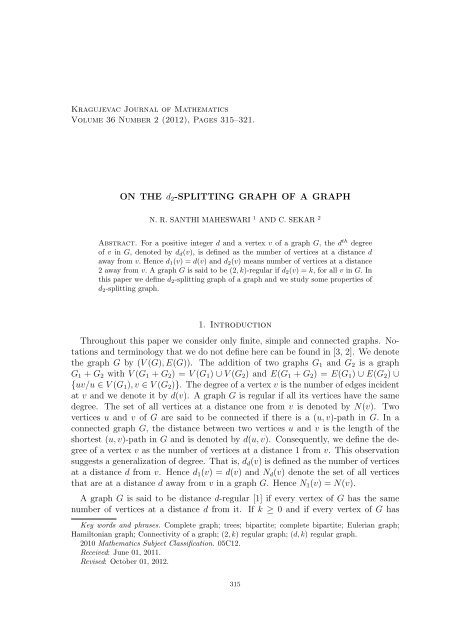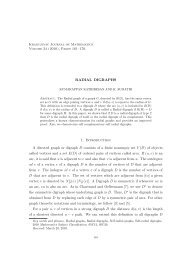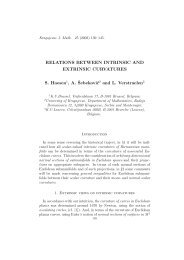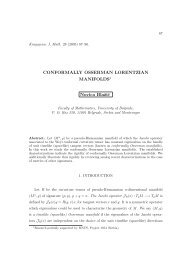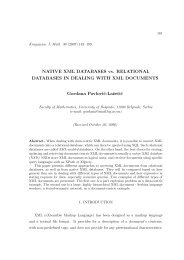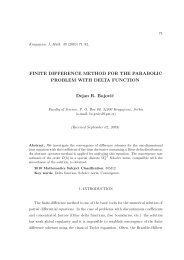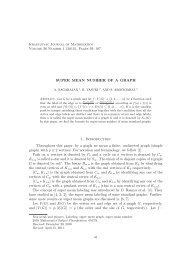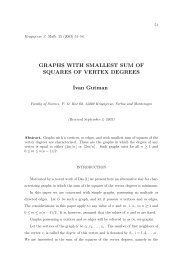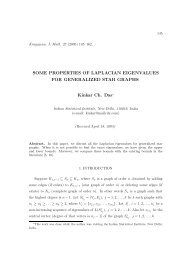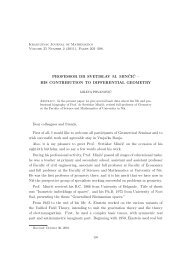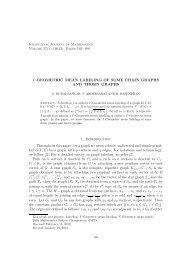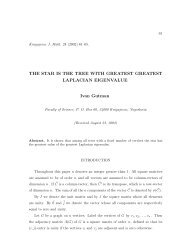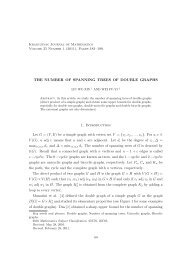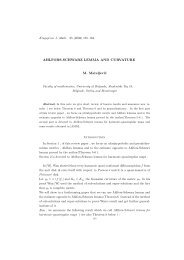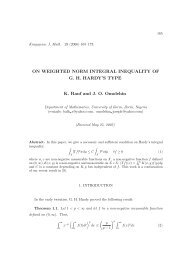ON THE d2-SPLITTING GRAPH OF A GRAPH 1 ... - Kjm.pmf.kg.ac.rs
ON THE d2-SPLITTING GRAPH OF A GRAPH 1 ... - Kjm.pmf.kg.ac.rs
ON THE d2-SPLITTING GRAPH OF A GRAPH 1 ... - Kjm.pmf.kg.ac.rs
You also want an ePaper? Increase the reach of your titles
YUMPU automatically turns print PDFs into web optimized ePapers that Google loves.
Kragujev<strong>ac</strong> Journal of Mathematics<br />
Volume 36 Number 2 (2012), Pages 315–321.<br />
<strong>ON</strong> <strong>THE</strong> d 2 -<strong>SPLITTING</strong> <strong>GRAPH</strong> <strong>OF</strong> A <strong>GRAPH</strong><br />
N. R. SANTHI MAHESWARI 1 AND C. SEKAR 2<br />
Abstr<strong>ac</strong>t. For a positive integer d and a vertex v of a graph G, the d th degree<br />
of v in G, denoted by d d (v), is defined as the number of vertices at a distance d<br />
away from v. Hence d 1 (v) = d(v) and d 2 (v) means number of vertices at a distance<br />
2 away from v. A graph G is said to be (2, k)-regular if d 2 (v) = k, for all v in G. In<br />
this paper we define d 2 -splitting graph of a graph and we study some properties of<br />
d 2 -splitting graph.<br />
1. Introduction<br />
Throughout this paper we consider only finite, simple and connected graphs. Notations<br />
and terminology that we do not define here can be found in [3, 2]. We denote<br />
the graph G by (V (G), E(G)). The addition of two graphs G 1 and G 2 is a graph<br />
G 1 + G 2 with V (G 1 + G 2 ) = V (G 1 ) ∪ V (G 2 ) and E(G 1 + G 2 ) = E(G 1 ) ∪ E(G 2 ) ∪<br />
{uv/u ∈ V (G 1 ), v ∈ V (G 2 )}. The degree of a vertex v is the number of edges incident<br />
at v and we denote it by d(v). A graph G is regular if all its vertices have the same<br />
degree. The set of all vertices at a distance one from v is denoted by N(v). Two<br />
vertices u and v of G are said to be connected if there is a (u, v)-path in G. In a<br />
connected graph G, the distance between two vertices u and v is the length of the<br />
shortest (u, v)-path in G and is denoted by d(u, v). Consequently, we define the degree<br />
of a vertex v as the number of vertices at a distance 1 from v. This observation<br />
suggests a generalization of degree. That is, d d (v) is defined as the number of vertices<br />
at a distance d from v. Hence d 1 (v) = d(v) and N d (v) denote the set of all vertices<br />
that are at a distance d away from v in a graph G. Hence N 1 (v) = N(v).<br />
A graph G is said to be distance d-regular [1] if every vertex of G has the same<br />
number of vertices at a distance d from it. If k ≥ 0 and if every vertex of G has<br />
Key words and phrases. Complete graph; trees; bipartite; complete bipartite; Eulerian graph;<br />
Hamiltonian graph; Connectivity of a graph; (2, k) regular graph; (d, k) regular graph.<br />
2010 Mathematics Subject Classification. 05C12.<br />
Received: June 01, 2011.<br />
Revised: October 01, 2012.<br />
315
316 SANTHI MAHESWARI AND SEKAR<br />
ex<strong>ac</strong>tly k number of vertices at a distance d from it, then we call this graph by (d, k)-<br />
regular graph. That is, a graph G is said to be (d, k)-regular graph if d d (v) = k, for<br />
all v in G. The (1, k)-regular graphs and regular graphs are the same. (d, k)-regular<br />
graphs are natural extension of regular graphs. A graph G is said to be (2, k)-regular<br />
if d 2 (v) = k, for all v in G, where d 2 (v) denotes number of vertices at a distance 2<br />
from v.<br />
Splitting graph S(G) was introduced by Sampath Kumar and Walikar [5]. For e<strong>ac</strong>h<br />
vertex v of a graph G, take a new vertex v ′ and join v ′ to all vertices of G adj<strong>ac</strong>ent<br />
to v. The graph S(G) thus obtained is called the splitting graph of G.<br />
In the similar way, degree splitting graph DS(G) was introduced by R. Ponraj and<br />
S. Somasundaram [4]. Let G = (V, E) be a graph with V = S 1 ∪ S 2 ∪ · · · ∪ S t ∪ T ,<br />
where e<strong>ac</strong>h S i is a set of vertices having at least two vertices and having the same<br />
degree and T = V − ∪S i . The degree splitting graph of G denoted by DS(G) is<br />
obtained from G by adding vertices w 1 , w 2 , . . . , w t and joining w i to e<strong>ac</strong>h vertex of S i<br />
(1 ≤ i ≤ t).<br />
We define d 2 -splitting graph of G denoted by D 2 S(G) and we investigate some<br />
properties of D 2 S(G).<br />
2. d 2 -splitting graph<br />
Definition 2.1. Let G be a graph with V (G) = V 1 ∪ V 2 ∪ V 3 ∪ · · · ∪ V w ∪ W where<br />
e<strong>ac</strong>h V i is a set having at least two vertices, all having the same d 2 and W = V − ∪V i .<br />
The d 2 -splitting graph of G denoted by D 2 S(G) is obtained from G by introducing<br />
new vertices u 1 , u 2 , . . . , u w and joining u i to e<strong>ac</strong>h vertex of V i (1 ≤ i ≤ w).<br />
Example 2.1.<br />
1<br />
<br />
1<br />
<br />
❆<br />
❆<br />
❆<br />
❆<br />
❆❆<br />
❆<br />
❆❆❆❆<br />
❆<br />
<br />
2 3 4 5<br />
G<br />
<br />
2 3 4 5<br />
Figure 1.<br />
w 1<br />
<br />
D 2 S(G)<br />
Here, V 1 = {2, 3, 4, 5}, W = {1}.
<strong>ON</strong> <strong>THE</strong> d 2 -<strong>SPLITTING</strong> <strong>GRAPH</strong> <strong>OF</strong> A <strong>GRAPH</strong> 317<br />
1<br />
1<br />
<br />
2 5 3<br />
<br />
2 5 3<br />
u e<br />
<br />
4<br />
G<br />
Here, V 1 = {1, 4}, V 2 = {2, 3, 5}, W = φ.<br />
<br />
4<br />
u d<br />
D 2 S(G)<br />
Figure 2.<br />
Observation 2.1. In a graph with more than one vertex, at least two vertices have the<br />
same degree d 2 .<br />
Observation 2.2. Trivial graph K 1 is the only graph such that K 1 = D 2 S(K 1 ).<br />
Observation 2.3. For any graph G ≠ K 1 , G is a sub graph of D 2 S(G).<br />
Observation 2.4. If G = K C n , then D 2 S(G) = K 1,n .<br />
Definition 2.2. Consider P n (n ≥ 6) and two new vertices u and v on either side of<br />
P n . Join the vertex v to fi<strong>rs</strong>t two vertices from the left and last two vertices of P n<br />
from the right. Join the vertex u to the remaining vertices of P n in the middle. The<br />
resulting graph is called Shipping graph and is denoted by SP n .<br />
Example 2.2. For a path on 6 vertices, the shipping graph SP 6 is shown in Figure 3.<br />
<br />
u<br />
v 1 v 2 v 3 v 4 v 5 v 6<br />
<br />
<br />
v<br />
Figure 3.<br />
Observation 2.5. If G = P n (n ≥ 6), then D 2 S(G) = SP n .<br />
Observation 2.6. If G = C n , then D 2 S(G) = W n .<br />
Observation 2.7. If G = W 4 , then D 2 S(G) = K 5 .<br />
Observation 2.8. If G = K n (n > 1), then D 2 S(G) = K n+1 .
318 SANTHI MAHESWARI AND SEKAR<br />
Observation 2.9. If G is a (2, k)-regular, then D 2 S(G) = G + K 1 .<br />
<br />
<br />
<br />
<br />
<br />
<br />
<br />
<br />
<br />
<br />
<br />
<br />
<br />
<br />
<br />
<br />
<br />
<br />
G<br />
<br />
<br />
D 2 S(G)<br />
<br />
Figure 4.<br />
Theorem 2.1. Let G be a graph with p vertices and q edges. If G(≠ K p ) is (2, k)-<br />
regular, then D 2 S(G) is not (2, k)-regular.<br />
Proof. Let G be (2, k)-regular with k > 0, that is, d 2 (v) = k for all v ∈ V (G). Let<br />
V (D 2 S(G) − V (G)) = {u}. Since u is adj<strong>ac</strong>ent to all the vertices of G, in D 2 S(G),<br />
d 2 (u) = 0. That is, d 2 (u) ≠ d 2 (v), for all v ∈ V (G). Hence D 2 S(G) is not (2, k)-<br />
regular.<br />
□<br />
Theorem 2.2. If G is a connected graph with at least one edge, then D 2 S(G) contains<br />
a cycle.<br />
Proof. Let G be a connected graph with |E(G)| ≥ 1.<br />
Case 1. If G contains a cycle, then D 2 S(G) also contains a cycle.<br />
Case 2. Suppose G contains no cycle. Since G is a connected graph with |E(G)| ≥ 1,<br />
G contains more than one vertex. By Observation 2.1 G contains at least two vertices<br />
having the same d 2 .<br />
Without loss of generality, let x and y be two vertices in G such that d 2 (x) = d 2 (y).<br />
By definition of D 2 S(G), it contains a vertex u such that u is adj<strong>ac</strong>ent with both x<br />
and y.<br />
Subcase 1. If x and y are adj<strong>ac</strong>ent, then u, x, y, u form a cycle in D 2 S(G).<br />
Subcase 2. If x and y are not adj<strong>ac</strong>ent, then they are connected by a path<br />
x = v 1 , v 2 , . . . , v n = y. Since G is connected, u, v 1 , . . . , v n , u is a cycle in D 2 S(G). □<br />
Remark 2.1. If G is a disconnected graph with |E(G)| ≥ 1, then at least one component<br />
of G has edge set, so by Theorem 2.2, D 2 S(G) contains a cycle.<br />
Result 2.1. Let G be a bipartite graph with bipartition (V 1 , V 2 ), where<br />
V 1 = {v 1 , v 2 , . . . , v m } and V 2 = {v1, 1 v2, 1 . . . , vn}. 1 If there is a pair of vertices v i and vj<br />
1<br />
such that the length of the v i - vj<br />
1 path is odd and d 2 (v i ) = d 2 (vj 1 ), then D 2 S(G) is
<strong>ON</strong> <strong>THE</strong> d 2 -<strong>SPLITTING</strong> <strong>GRAPH</strong> <strong>OF</strong> A <strong>GRAPH</strong> 319<br />
not bipartite. Also, if there is no pair of vertices v i and v 1 j such that d 2 (v i ) = d 2 (v 1 j ),<br />
then D 2 S(G) is bipartite.<br />
Theorem 2.3. D 2 S(K m,n ) is a bipartite graph if and only if m ≠ n.<br />
Proof. Let V 1 = {v 1 , v 2 , . . . , v m } and V 2 = {v1, 1 v2, 1 . . . , vn} 1 be the partition of V (K m,n ).<br />
Therefore d 2 (v i ) = m − 1 for i = 1, 2, . . . , m and d 2 (vj 1 ) = n − 1 for j = 1, 2, . . . , n.<br />
Suppose m ≠ n. Then m − 1 ≠ n − 1. Therefore, for i = 1, 2, . . . , m and j =<br />
1, 2, . . . , n, there is no pair v i and vj 1 such that d 2 (v i ) = d 2 (vj 1 ). Let V (D 2 S(K m,n ))\<br />
V (K m,n ) = {u 1 , u 2 }. Let u 1 be adj<strong>ac</strong>ent to every vertex in V 2 and u 2 be adj<strong>ac</strong>ent<br />
to every vertex in V 1 . Clearly, (V 1 ∪ {u 1 }, V 2 ∪ {u 2 }) is a bipartition of D 2 S(K m,n ).<br />
Therefore, (D 2 S(K m,n )) is a bipartite graph when m ≠ n.<br />
Conve<strong>rs</strong>ely, let D 2 S(K m,n ) be a bipartite graph. Suppose m = n. Then m − 1 =<br />
n−1, that is, d 2 (v) = m−1 for all v ∈ K m,n . Therefore, there exists a pair of adj<strong>ac</strong>ent<br />
vertices v i and vj 1 such that d 2 (v i ) = d 2 (vj 1 ). By definition of D 2 S(K m,n ), there exists<br />
a vertex u which is adj<strong>ac</strong>ent to both v i and vj 1 . Therefore, D 2 S(K m,n ) will contain the<br />
odd cycle u 1 v i vj 1 u 1 . This implies that D 2 S(K m,n ) is not a bipartite graph, which is a<br />
contradiction. Hence m ≠ n.<br />
□<br />
Theorem 2.4. D 2 S(K n,n ) is a tripartite graph.<br />
Proof. Let V 1 = {v 1 , v 2 , . . . , v n } and V 2 = {u 1 , u 2 , u 3 , . . . , u n } are the partition of<br />
V (K n,n ). Then d 2 (v i ) = n − 1 for i = 1, 2, . . . , n and d 2 (u j ) = n − 1 for j = 1, 2, . . . , n.<br />
By definition of D 2 S(G), D 2 S(K n,n ) contains a vertex u such that u is adj<strong>ac</strong>ent to<br />
all u i (i = 1, 2 . . . , n) and v j (j = 1, 2, . . . , n), that is, u is adj<strong>ac</strong>ent with all vertices<br />
of K n,n . D 2 S(K n,n ) is K 1,n,n and hence tripartite.<br />
□<br />
Result 2.2. For any graph G, ω(D 2 S(G)) ≤ ω(G), where ω(G) denotes the number<br />
of components of G.<br />
Proof. Case 1. If G is a connected graph, then D 2 S(G) is connected. Therefore,<br />
ω(G) = 1 = ω(D 2 S(G)).<br />
Case 2. If G is a disconnected graph then G has more than one component. Let<br />
us assume that G has two components G 1 and G 2 . Let x ∈ V (G 1 ) and y ∈ V (G 2 )<br />
such that d 2 (x) = d 2 (y). By definition of D 2 S(G), there exists a vertex u such that<br />
u is adj<strong>ac</strong>ent to both x and y. Hence ω(D 2 S(G)) = 1 < ω(G). Suppose that either x<br />
and y are in V (G 1 ) or x and y are in V (G 2 ). Then ω(D 2 S(G)) = 2 = ω(G). Hence<br />
ω(D 2 S(G)) ≤ ω(G).<br />
□<br />
Theorem 2.5. If G is an Eulerian graph, then D 2 S(G) is not an Eulerian graph.<br />
Proof. Let G be an Eulerian graph. Since G is an Eulerian graph, e<strong>ac</strong>h vertex in G<br />
is of even degree. By Observation 2.1, G contains at least two vertices having the<br />
same d 2 . Let x and y be two vertices in G such that d 2 (x) = d 2 (y). By definition of<br />
D 2 S(G), there exits a vertex u which is adj<strong>ac</strong>ent to both x and y. Therefore, degree<br />
of x in D 2 S(G) = (degree of x in G) + 1 = even + 1 = odd. Degree of x and y in<br />
D 2 S(G) are odd. Therefore, D 2 S(G) is not an Eulerian graph.<br />
□
320 SANTHI MAHESWARI AND SEKAR<br />
Theorem 2.6. Let G be a graph with p vertices and q edges and let s be the number<br />
of vertices in W. Then |E(D 2 S(G))| = p + q − s where W is as in Definition 2.1.<br />
Proof. Let V (G) = {v 1 , v 2 , v 3 , . . . , v p } and V (D 2 S(G))−V (G) = {u 1 , u 2 , . . . , u s }. Let<br />
d ′ (v) denote the degree of a vertex v[ in D 2 S(G) (clearly d ′ (v) ≤ d(v), for all v in G).<br />
Then |E(D 2 S(G))| = 1 ∑ p ]<br />
2 d ′ (v) = 1 ∑<br />
(d(v<br />
2<br />
i ) + 1) − s + p − s = p + q − s. □<br />
Remark 2.2. If G is a (2, k)-regular graph, then |E(D 2 S(G))| = p + q.<br />
i=1<br />
Theorem 2.7. D 2 S(K n,n ) is a Hamiltonian graph.<br />
Proof. For n ≥ 1, the number of vertices in D 2 S(K n,n ) = 2n + 1 = p ≥ 3. Minimum<br />
degree of the graph D 2 S(K n,n ) is n + 1, that is, p = 2n + 1 and δ = n + 1. Therefore,<br />
δ ≥ p . By Dir<strong>ac</strong>’s theorem, D 2 2S(K n,n ) is a Hamiltonian graph.<br />
□<br />
Theorem 2.8. D 2 S(K m,n ) is a Non-Hamiltonian graph with m ≠ n.<br />
Proof. Let V 1 = {v 1 , v 2 , . . . , v m } and V 2 = {u 1 , u 2 , u 3 , . . . , u n } be the partition of<br />
V (K m,n ). Assume m < n. Here V (D 2 S(K m,n )) = {V 1 ∪ {u 1 }} ∪ {V 2 ∪ {u 2 }}, u 1<br />
is adj<strong>ac</strong>ent with all the vertices of V 2 and u 2 is adj<strong>ac</strong>ent to all the vertices of V 1 .<br />
Therefore, |V 1 ∪ {u 1 }| = m + 1 and |V 2 ∪ {u 2 }| = n + 1. Then<br />
(ω(D 2 S(K m,n )) − {V 1 ∪ {u 1 }}) = n + 1 > m + 1 = |V 1 ∪ {u 1 }|.<br />
Hence D 2 S(K m,n ) is a Non-Hamiltonian.<br />
Note 2.1. D 2 S(G) of a disconnected graph G may be connected. For instance, let G<br />
be a graph with two components G 1 and G 2 such that G 1 and G 2 are (2, k)-regular<br />
and e<strong>ac</strong>h vertex of G 1 and G 2 have the same d 2 . Then, by definition of D 2 S(G), there<br />
exists a vertex which is adj<strong>ac</strong>ent to all the vertices of G 1 and G 2 . Therefore D 2 S(G)<br />
is connected.<br />
Theorem 2.9. Let G be a connected graph. Then K(D 2 S(G)) ≥ K(G).<br />
Proof. Let G be a connected graph with vertex set V (G) = {v 1 , v 2 , v 3 , . . . , v n }. Let<br />
V (D 2 S(G)) − V (G)) = {u 1 , u 2 , u 3 , . . . , u w }. Since G is a connected graph, by Observation<br />
2.1, G contains at least two vertices having same d 2 and they are connected<br />
by a path. Let v i and v j be the vertices of G such that d 2 (v i ) = d 2 (v j ) and v i and v j<br />
are connected by a path. Suppose G is k-connected. Let S = {v 1 , v 2 , v 3 , . . . , v k } be<br />
the minimum vertex cut of G. Since G − S is disconnected, G − S has at least two<br />
components. Take two components G 1 and G 2 .<br />
Case 1. Suppose v i and v j are in the same component. Then K(D 2 S(G)) = K(G).<br />
Case 2. Suppose v i and v j belong to different components. Without loss of generality,<br />
let v i ∈ G 1 and v j ∈ G 2 . Then there is no v i -v j path in G − S. But v i and v j are<br />
connected by a path v i u i v j in (D 2 S(G)−S). That is, D 2 S(G)−S is connected. Hence<br />
K(D 2 S(G)) ≥ K(G).<br />
□<br />
□
<strong>ON</strong> <strong>THE</strong> d 2 -<strong>SPLITTING</strong> <strong>GRAPH</strong> <strong>OF</strong> A <strong>GRAPH</strong> 321<br />
References<br />
[1] G.S. Bloom, J.K. Kennedy and L.V. Quintas, Distance degree Regular Graphs. In G. Chartrand<br />
Editor. The Theory and Applications of Graphs, John Wiley, New York, (1981), 95–108.<br />
[2] J.A. Bondy and U.S.R. Murty, Graph Theory with Application, M<strong>ac</strong>Millan, London (1979).<br />
[3] F. Harary, Graph theory, Addison - Wesley, (1969).<br />
[4] R. Ponraj and S. Somasundaram, On the degree splitting graph of a graph, NATL ACAD SCI<br />
LETT, 27(7& 8) (2004), 275–278.<br />
[5] E. Sampathkumar and H.B. Walikar, On Splitting Graph of a Graph, J. Karnatak Univ. Sci.,<br />
25(13) (1980), 13–16.<br />
1 Department of Mathematics,<br />
G. Venkataswamy Naidu College,<br />
Kovilpatti-628 502, Tamil Nadu, India.<br />
E-mail address: n<strong>rs</strong>maths@yahoo.com<br />
2 Department of Mathematics,<br />
Aditanar College of Arts and Science,<br />
Tiruchendur, Tamil Nadu, India.<br />
E-mail address: sekar.<strong>ac</strong>as@gmail.com


